Study on the Deformation Mechanisms of the Surrounding Rock and Its Supporting Technology for Large Section Whole Coal Cavern Groups
Abstract
:1. Introduction
2. Study Area
3. Method and Material
3.1. Solve the Loose Circle of the Rectangular Roadway Based on the Equivalent Circular Method
- (1)
- Construction of the mechanical model of the equivalent circle method expression
- (2)
- Calculate the stress in the loose zone of the roadway surrounding the rock
- r0 is the radius of the circular roadway, m;
- r1 is the radius of the loose ring, m;
- θ is the polar angle of any point in the plastic zone of the surrounding rock, °;
- (3)
- Determine the expression based on the equivalent circle method
- .
3.2. Numerical Calculation
4. Results and Discussion
4.1. Deformation Law of Surrounding Rock with Different Lateral Pressure Coefficients
4.2. Stress Variation Characteristics for the Whole Coal Cavern Group
- (1)
- The simulation result at h = 3 m
- (2)
- The simulation result at h = 5 m
- (3)
- The simulation result at h = 8 m
- (4)
- Stress distribution characteristics of cavern groups at different heights
4.3. Displacement Characteristics of the Whole Coal Cavern Group
4.4. Control Technology and Application for Large Section Whole Coal Cavern Groups
4.4.1. A Novel Stratified Reinforcement Ring Concept of the LBG
- (1)
- The surrounding rock of the cavern is divided into the fracture zone, the plastic zone, and the elastic zone from a shallow part to a deep part. The damage degree decreases gradually, and the support strength required to achieve stability also decreases gradually. The coordinated support of an anchor bolt, a grouting anchor cable, and a long anchor cable can meet this requirement. In the shallow part of the surrounding rock, the supporting density demand of a bolt, a grouted anchor cable, and a long anchor cable is small, while the supporting strength demand is large. In the deep surrounding rock, the support density demand decreases successively, and the support intensity decreases correspondingly. By partitioning the surrounding rock and adding reinforcement, a stable bearing circle that is consistent with the surrounding rock can be formed. For the fracture zone (0–2.5 m), plastic zone (3–8 m), and elastic zone (beyond 8 m), the coordinated support technology of an anchor bolt (3 m), a grouting anchor cable (8.3 m), and a long anchor cable (15 m) has been proposed and adopted to connect the broken zone, the plastic zone, and the elastic zone. Three kinds of supporting equipment are arranged at intervals and form three stable bearing rings of 0–3 m, 3–8 m, and 8–15 m from the shallow to deep layer of the surrounding rock;
- (2)
- By using a high-strength and high-preload anchor cable support, the supporting function of an anchor bolt cable and the bearing capacity of surrounding rock can be fully demonstrated. In the early stages of excavation of a large section cavern, the surrounding rock’s deformation speed is greater. A high-prestressed anchor bolt and a cable support can not only provide greater initial support resistance but also have good resistance-increasing performance, so that the rock strata in the broken zone, the plastic zone, and the elastic zone are locked as a whole. The internal friction angle and cohesion of the rock strata within the anchorage range can be improved so as to realize active and timely support and effectively limit the development of surrounding rock deformation and failure;
- (3)
- Partition grouting reinforcement can improve the mechanical properties and stability of the surrounding rock. The cable support, with its high strength and high preload, can effectively control the deformation of the surrounding rock. However, primary and new fissures in the surrounding rock will expand to a certain extent. In order to achieve long-term stability of the surrounding rock, it is still necessary to improve the strength of the rock by grouting. Partition grouting reinforcement is mainly used to reinforce the fracture zone (0–2.5 m) and the plastic zone (3–8 m), respectively. Firstly, low-pressure grouting of a shallow hole is applied to the fracture zone, and then high-pressure grouting of the deep hole is applied to the surrounding rock in the plastic area. The grouting effect can be improved effectively through the combination of deep- and shallow-hole grouting. After grouting, the anchoring effect and supporting stiffness of an anchor bolt and an anchor cable are further strengthened, and the stability of the surrounding rock is further improved.
4.4.2. Determine the Surrounding Rock Control Parameters of the Whole Coal Cavern Group
- (1)
- Roof support parameters of the cavern group
- (2)
- Grouting parameters
5. Verification and Application
5.1. Numerical Simulation Results of LBG Control Technology
5.2. Engineering Practice
6. Conclusions
- (1)
- A mechanical model for WCCG with a rectangular roadway is established and solved based on an equivalent circular method. The theoretical calculation results showed that the heights of a loose ring in the roof and its two sides are 3.34 m and 2.54 m, respectively. It provides guidance for determining the supporting parameters of the whole coal cavern group;
- (2)
- A numerical model under different section parameters is established for the linkage impact between whole coal cavern groups and the large section. With the increase of the lateral pressure coefficient, the stress concentration area on both sides of the caverns first increases laterally and then changes to a longitudinal diffusion. The plastic zone of the cavern tends to decrease with an increase in the lateral pressure coefficient. The range of the plastic zone decreases gradually on the two sides of the cavern, thus extending gradually to the top and bottom floors. The distribution of the plastic zone changed from stocky to tall. The stress and deformation mechanisms of the surrounding rock provide the basis for the control theory and parameters of the surrounding rock in the WCCG with a large section;
- (3)
- The surrounding rock of the whole coal cavern group presents an asymmetric pressure relief form due to the excavation of the cavern. Far away from the surface of the cavern, the stress gradually increases, and the stress concentration appears in the depths. The stress concentration on the two sides is greater than that on the top and bottom. In the shallow part of the surrounding rock, tensile failure or tensile shear failure mainly occurs, and shear failure mainly occurs in the deep part of the surrounding rock. The bearing capacity of the surrounding rock is greatly reduced due to the excavation of the cavern. It is necessary to improve its stability through active, strong support;
- (4)
- The stratified reinforcement ring concept of a LBG is proposed based on the obtained deformation mechanism to control surrounding rock deformation of the WCCG. The supporting technology of an anchor bolt (3 m), grouting anchor cable (8.3 m), and a long anchor cable (15 m) is proposed and adopted to connect the broken zone, the plastic zone, and the elastic zone in the gas storage cavern group with the large section. The roof subsidence and two-sided displacement are controlled at 140 mm and 120 mm, respectively, by using the supporting scheme of a LBG, and the surrounding rock deformation in the caverns is obviously reduced. The results of the numerical simulation and the field monitoring show that the LBG technology is effective for the stability control of the WCCG.
Author Contributions
Funding
Data Availability Statement
Conflicts of Interest
References
- Du, F.; Wang, K.; Wang, G.; Huang, Y.; Yi, L. The mechanism of damage in gas-bearing coal-rock combination bodies and gas seepage in coals. Energy Sour. Part A Recovery Util. Environ. Eff. 2021, 43, 1181–1201. [Google Scholar] [CrossRef]
- Wang, W.; Wang, H.; Li, D.; Li, H.; Liu, Z. Strength and failure characteristics of naturaland water-saturated coal specimens under static and dynamic loads. Shock. Vib. 2018, 2018, 3526121. [Google Scholar]
- Du, F.; Ma, J.; Guo, X.; Wang, T.; Dong, X.; Li, J.; He, S.; Nuerjuma, D. Rockburst mechanism and the law of energy accumulation and release in mining roadway: A case study. Int. J. Coal Sci. Technol. 2022, 9, 1–17. [Google Scholar] [CrossRef]
- Zhang, J.; Li, B.; Liu, Y.; Li, P.; Fu, J.; Chen, L.; Ding, P. Dynamic multifield coupling model of gas drainage and a new remedy method for borehole leakage. Acta Geotech. 2022, 17, 4699–4715. [Google Scholar] [CrossRef]
- Li, B.; Zhang, J.; Liu, Y.; Qu, L.; Liu, Q.; Sun, Y.; Xu, G. Interfacial porosity model and modification mechanism of broken coal grouting: A theoretical and experimental study. Surf. Interfaces 2022, 33, 102286. [Google Scholar] [CrossRef]
- Bai, Q.; Tu, S.; Wang, F.; Zhang, C. Field and numerical investigations of gateroad system failure induced by hard roofs in a longwall top coal caving face. Int. J. Coal Geol. 2017, 173, 176–199. [Google Scholar] [CrossRef]
- Chen, H.D.; Chen, X.J.; Wang, Z.F.; Li, Z.; An, F. Plastic zone range of a roadway considering the creep effect. Sci. Rep. 2020, 10, 20341. [Google Scholar] [CrossRef]
- Zhang, Z.; Deng, M.; Bai, J.; Yan, S.; Yu, X. Stability control of gob-side entry retained under the gob with close distance coal seams. Int. J. Min. Sci. Technol. 2021, 31, 321–332. [Google Scholar] [CrossRef]
- Yuan, L.; Xue, J.H.; Liu, Q.S.; Liu, B. Surrounding rock stability control theory and support technique in deep rock roadway for coal mine. Meitan Xuebao/J. China Coal Soc. 2011, 36, 535–543. [Google Scholar]
- Kang, H. Sixty year’development and prospects of rock bolting technology for underground coal mine roadways in China. J. China Univ. Min. Technol. 2016, 45, 1071–1081. [Google Scholar]
- He, M.; Gong, W.; Wang, J.; Qi, P.; Tao, Z.; Du, S.; Peng, Y. Development of a novel energy-absorbing bolt with extraordinarily large elongation and constant resistance. Int. J. Rock Mech. Min. Sci. 2014, 67, 29–42. [Google Scholar] [CrossRef]
- Sun, X.M.; Zhang, G.F.; Cai, F.; Yu, S.B. Asymmetric deformation mechanism within inclinde rock strata induced by excavation in deep roadway and its controlling countermeasure. Chin. J. Rock Mech. Eng. 2009, 28, 1137–1143. [Google Scholar]
- Deng, J.Q.; Yang, Q.; Liu, Y.R.; Pan, Y.W. Stability evaluation and failure analysis of rock salt gas storage caverns based on deformation reinforcement theory. Comput Geotech. 2015, 68, 147–160. [Google Scholar] [CrossRef]
- Moghadam, S.N.; Nazokkar, K.; Chalaturnyk, R.J.; Mirzabozorg, H. Parametric assessment of salt cavern performance using a creep model describing dilatancy and failure. Int. J. Rock Mech. Min. 2015, 79, 250–267. [Google Scholar] [CrossRef]
- Wang, T.; Yang, C.; Ma, H.; Li, Y.; Shi, X.; Li, J.; Daemen, J.J.K. Safety evaluation of salt cavern gas storage close to an old cavern. Int. J. Rock Mech. Min. 2016, 83, 95–106. [Google Scholar] [CrossRef]
- Kang, H.P. Spatial scale analysis on coal mining and strata control technologies. J. Min. Strat. Control Eng. 2020, 2, 5–30. [Google Scholar]
- Kang, H.P. Temporal scale analysis on coal mining and stratac ontroltechnologies. J. Min. Strat. Control Eng. 2021, 3, 013538. [Google Scholar]
- Pan, Y.S.; Lv, X.F.; Li, Z.H.; Dai, S. Experimental study of dynamic failure process of roadway under high velocity impact loading. Rock Soil Mech. 2011, 32, 1281–1286. [Google Scholar]
- Wang, S.W.; Liu, H.D.; Jiang, T. Large geomechanical model test on failure mechanism of rockburst tunnel under static and explosive loads. Chin. J. Rock Mech. Eng. 2014, 33, 2095–2100. [Google Scholar]
- Shreedharan, S.; Kulatilake, P.H.S.W. Discontinuum-Equivalent continuum analysis of the stability of tunnels in a deep coal mine using the distinct element method. Rock Mech. Rock Eng. 2016, 49, 1903–1922. [Google Scholar] [CrossRef]
- Deng, J.Q.; Yang, Q.; Liu, Y.R. Time-dependent behavior and stability evaluation of gas storage caverns in salt rock based on deformation reinforcement theory. Tunn. Undergr. Sp. Tech. 2014, 42, 277–292. [Google Scholar] [CrossRef]
- Wu, H.; Jia, Q.; Wang, W.; Zhang, N.; Zhao, Y. Experimental test on nonuniform deformation in the tilted strata of a deep coal mine. Sustainability 2021, 13, 13280. [Google Scholar] [CrossRef]
- Zhao, Y.; Liu, Q.; Zhang, C.; Liao, J.; Lin, H.; Wang, Y. Coupled seepage-damage effect in fractured rock masses: Model development and a case study. Int. J. Rock Mech. Min. Sci. 2021, 144, 104822. [Google Scholar] [CrossRef]
- Wang, Q.; Zhan, H.J.; Jiang, B.; Huang, Y.B.; Zhang, P.; Xu, S.; Liu, B.H. Failure mechanism of deep large section cavern and anchor injection control method. J. Min. Saf. Eng. 2020, 37, 1094–1103. [Google Scholar]
- Wang, Q.; Jiang, B.; Pan, R.; Li, S.-C.; He, M.-C.; Sun, H.-B.; Qin, Q.; Yu, H.-C.; Luan, Y.-C. Failure mechanism of surrounding rock with high stress and con-fined concrete support system. Int. J. Rock Mech. Min. Sci. 2018, 102, 89–100. [Google Scholar] [CrossRef]
- Wang, Q.; Gao, H.; Yu, H.; Jiang, B.; Liu, B. Method for measuring rock mass characteristics and evaluating the grouting reinforced effect based on digital drilling. J. Rock Mech. Rock Eng. 2019, 52, 841–851. [Google Scholar] [CrossRef]
- Hou, C.J. Effective approach for surrounding rock control in deep roadway. J. China Univ. Min. Technol. 2017, 46, 577–583. [Google Scholar]
- He, M.C.; Li, G.F.; Ren, A.W.; Yang, J. Analysis of the stability of intersecting caverns in deep soft-rock roadway construction. J. China Univ. Min. Technol. 2008, 37, 167–170. [Google Scholar]
- Yang, R.S.; Xue, J.H.; Guo, D.M.; Li, Y. Failure mechanism of surrounding rock of large section caverns in complex rock formations and its control. J. China Coal Soc. 2015, 40, 2234–2242. [Google Scholar]
- Kang, Y.; Liu, Q.; Gong, G.; Wang, H. Application of a combined support system to the weak floor reinforcement in deep underground coal mine. Int. J. Rock Mech. Min. Sci. 2014, 71, 143–150. [Google Scholar] [CrossRef]
- Jiao, Y.Y.; Song, L.; Wang, X.Z.; Adoko, A.C. Improvement of the U-shaped steel sets for supporting the roadways in loose thick coal seam. Int. J. Rock Mech. Min. Sci. 2013, 60, 19–25. [Google Scholar] [CrossRef]
- Li, X.H.; Yao, Q.L.; Zhang, N. Fracture characteristics of a soft rock roadway: Staged and zoned control. J. China Univ. Min. Technol. 2009, 38, 618–623. [Google Scholar]
- Li, S.C.; Wang, H.T.; Wang, Q.; Jiang, B.; Wang, F.Q.; Guo, N.B.; Liu, W.; Ren, Y.X. Failure mechanism of bolting support and high-strength bolt-grouting technology for deep and soft surrounding rock with high stress. J. Cent. South Univ. 2016, 23, 440–448. [Google Scholar] [CrossRef]
- Singh, R.P.; Mousumi, M.; Verma, M.K. Studies on the failure behavior of wire rope used in underground coal mines. Eng. Fail Anal. 2016, 70, 290–304. [Google Scholar] [CrossRef]
- Ram, S.; Kumar, D.; Singh, A.K.; Kumar, A.; Singh, R. Field and numerical modelling studies for an efficient placement of roof bolts as breaker line support. Int. J. Rock Mech. Min. Sci. 2017, 93, 152–162. [Google Scholar] [CrossRef]
- Yuan, Z.; Zhao, J.; Li, S.; Jiang, Z.; Huang, F. A unified solution for surrounding rock of roadway considering seepage, dilatancy, strain-softening and intermediate principal stress. Sustainability 2022, 14, 8099. [Google Scholar] [CrossRef]
- Yu, W.; Li, K.; Liu, Z.; An, B.; Wang, P.; Wu, H. Mechanical characteristics and deformation control of surrounding rock in weakly cemented siltstone. Environ. Earth Sci. 2021, 80, 337. [Google Scholar] [CrossRef]
- Zheng, P.Q.; Liu, Y.Q.; Zhan, Z.W. Research on support optimization of rectangular roadway based on equivalent circle method. Coal Technol. 2022, 41, 10–13. [Google Scholar]
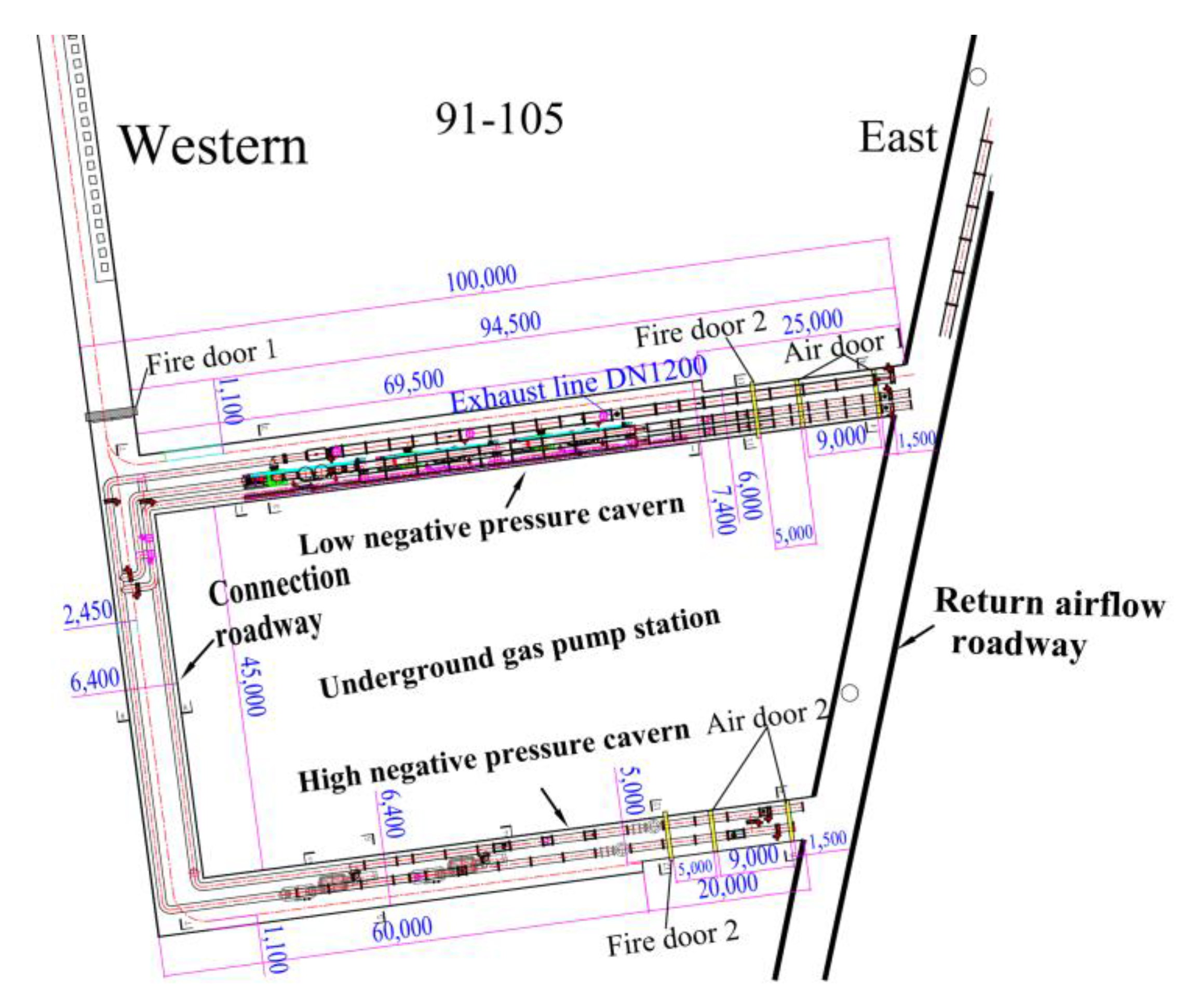


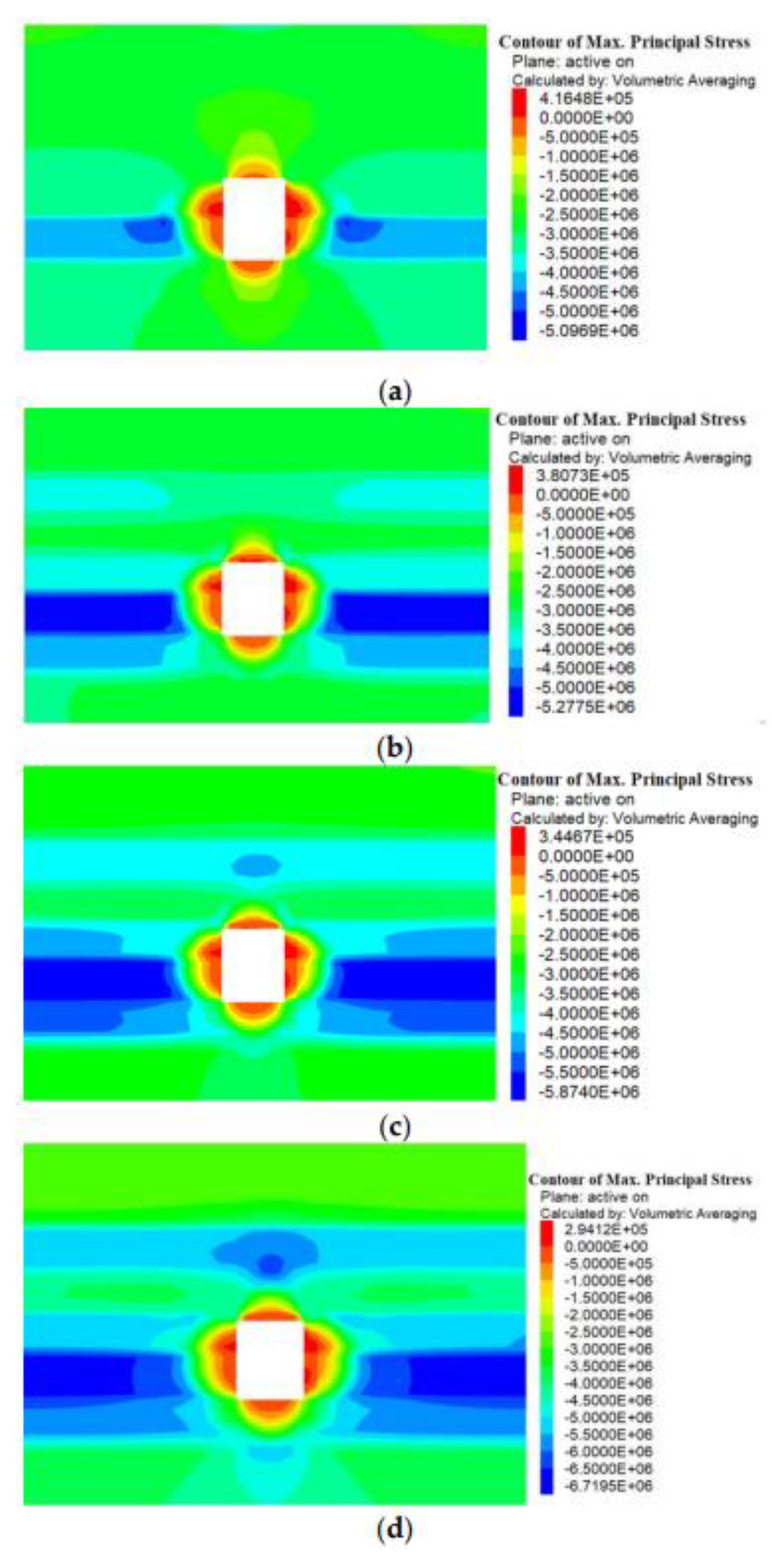

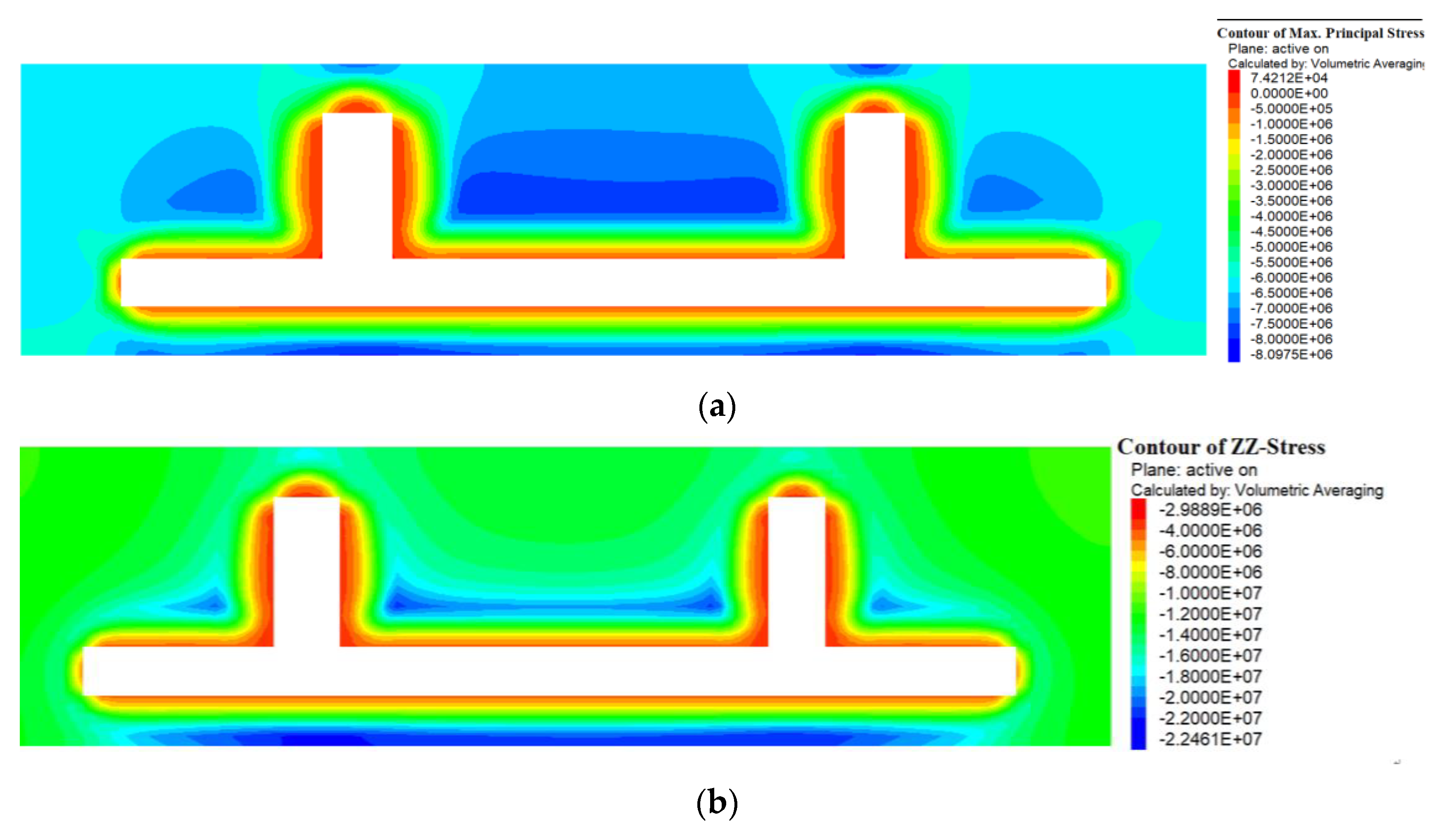



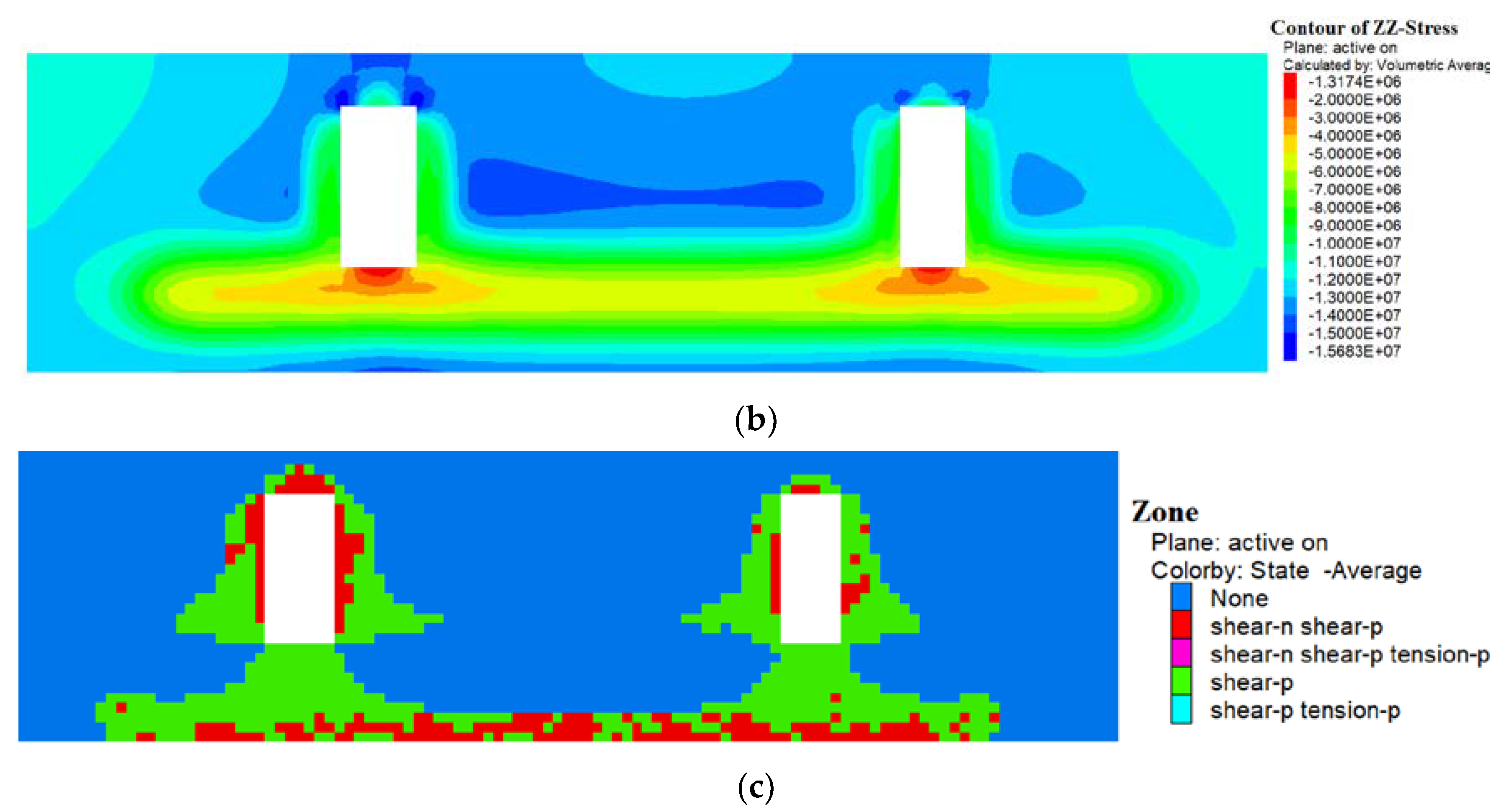
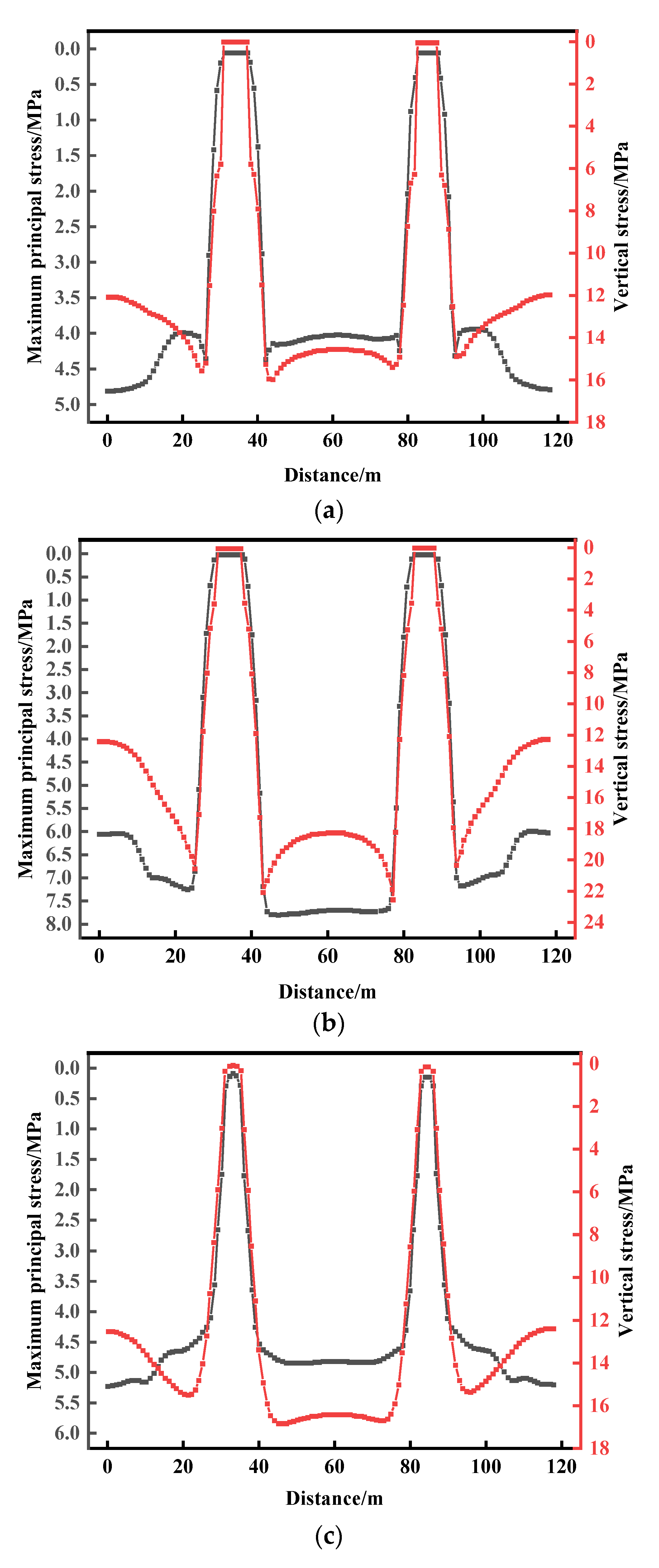

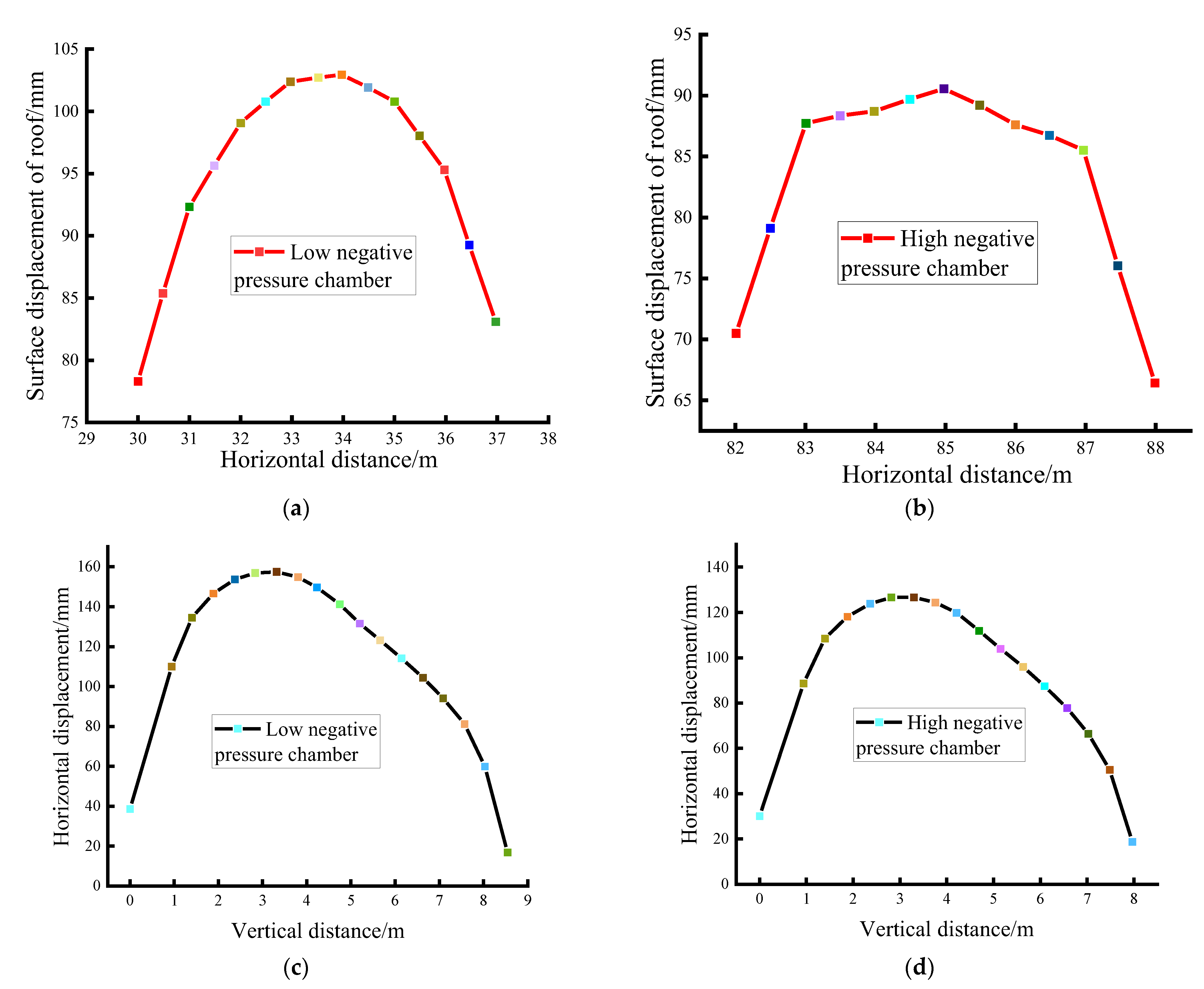



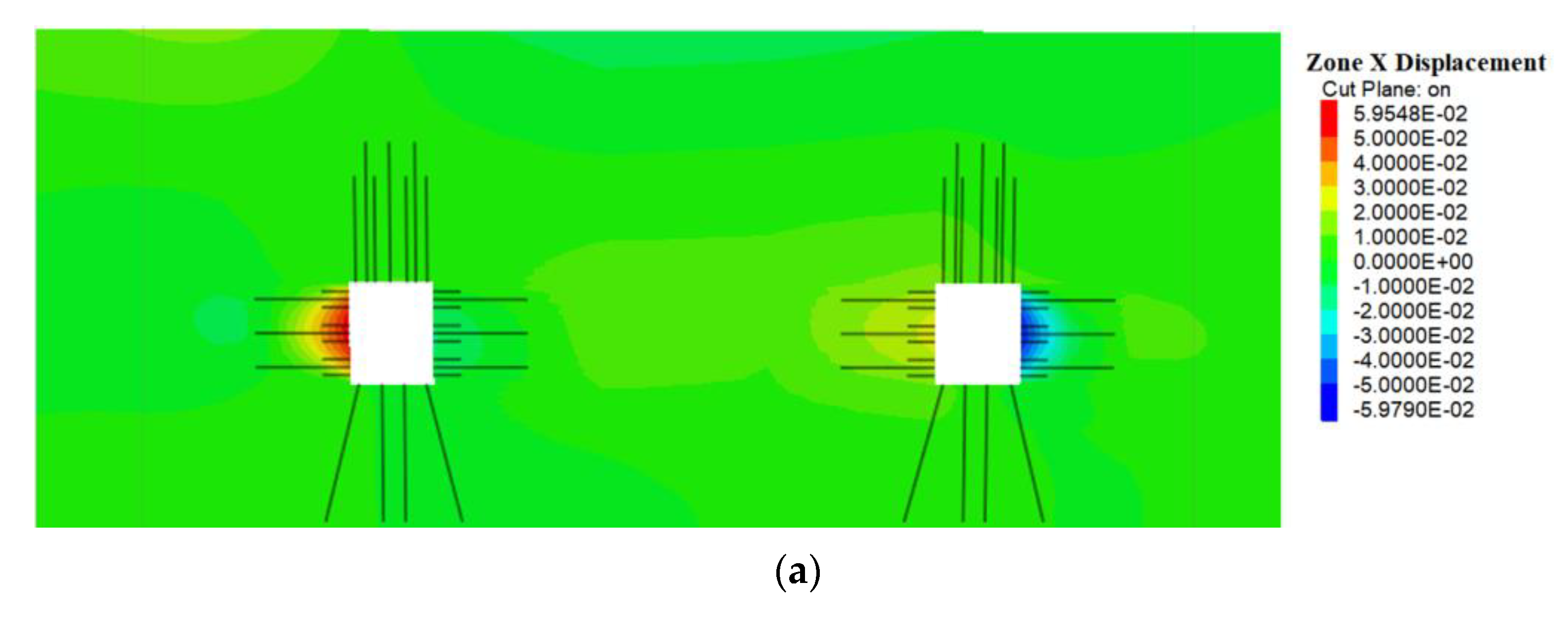
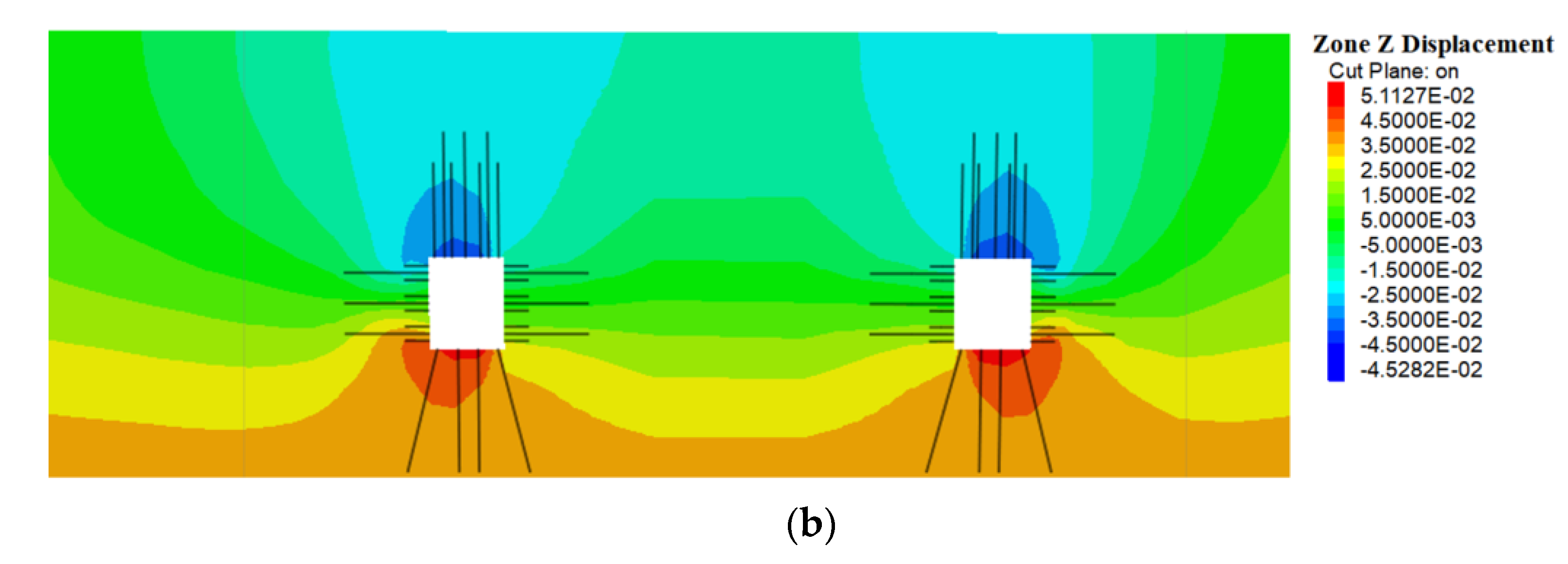



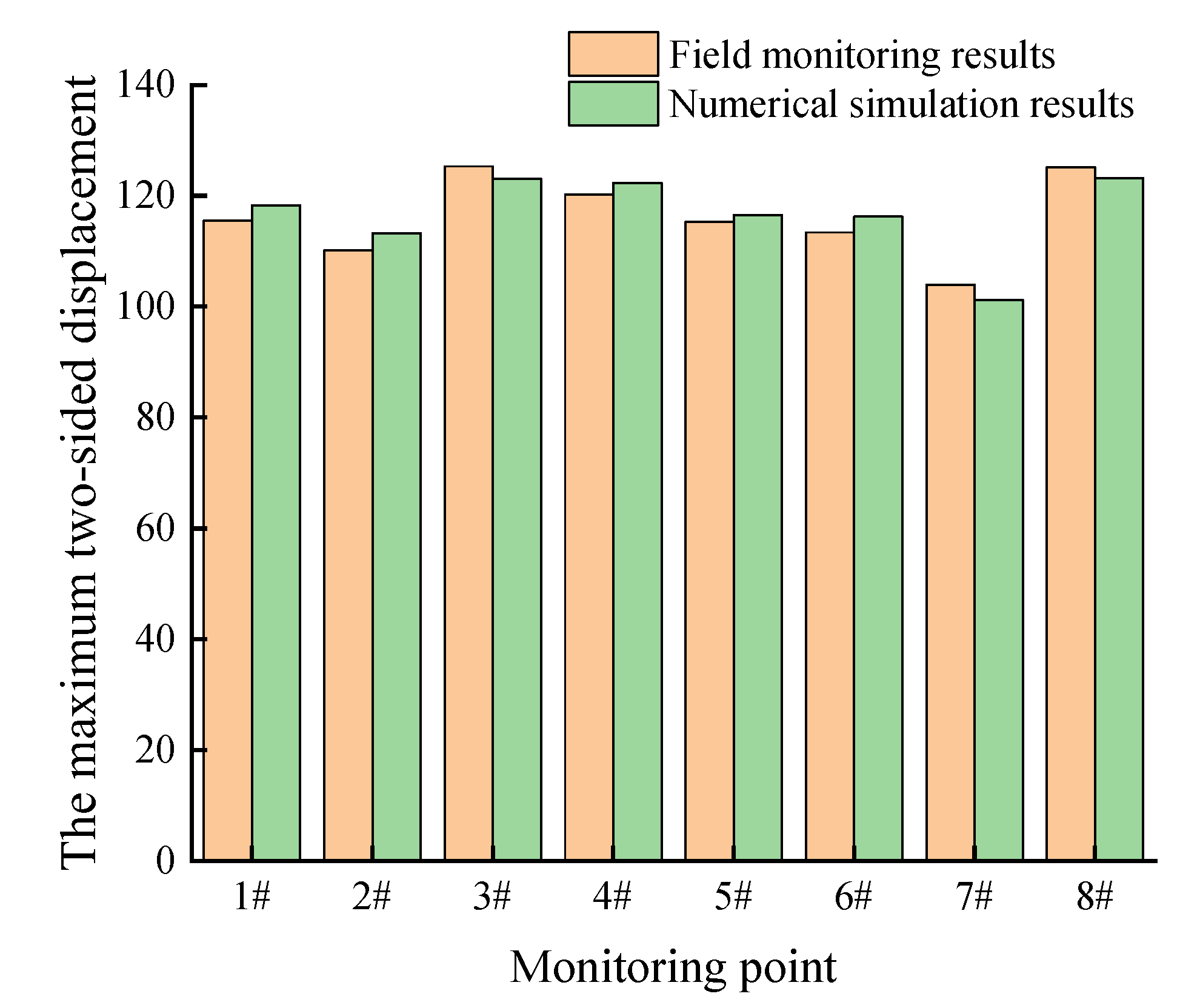


| Name of Roof and Bottom | Name of Rock | Thickness/m | Lithological Characteristics |
|---|---|---|---|
| Upper roof | Mudstone | 7 | The rock color is gray-black and belongs to the thick layer of fine-grained sand structure. There are many argillaceous rocks, mainly composed of quartz and feldspar, followed by other dark minerals. The rock mass is argillaceous cement. |
| Immediate roof | Sandy mudstone | 2.9 | The color of the rock mass is black and belongs to a silty argillaceous structure. The shape of the fracture is flat and has scratches. The rock mass contains pyrite. |
| Immediate bottom | Sandy mudstone | 3.95 | The rock mass is black in color and blocky in shape. The rock mass contains plant fossils and argillaceous cement. |
| Lower bottom | Limestone | 2.45 | The rock mass is gray in color and blocky in shape. The material quality is not pure and contains mud. |
| Lithology | Density/kg·m−3 | Bulk Modulus /GPa | Shear Modulus/GPa | Internal Friction Angle/° | Cohesion/MPa | Tensile Strength/MPa |
|---|---|---|---|---|---|---|
| Overlying strata | 2570 | 4.85 | 3.4 | 32 | 4.5 | 3.9 |
| Limestone | 2590 | 5.02 | 3.6 | 36 | 5.2 | 4.3 |
| Fine sandstone | 2512 | 3.51 | 2.5 | 33 | 3.4 | 3.0 |
| Sandy mudstone | 2500 | 3.04 | 2.2 | 30 | 2.3 | 2.5 |
| Coal seam | 1300 | 2.32 | 1.4 | 29 | 1.5 | 1.8 |
| Mudstone | 2200 | 2.8 | 1.8 | 28 | 2.6 | 2.2 |
| Underlying strata | 2550 | 4.5 | 3.2 | 31 | 3.1 | 3.5 |
Disclaimer/Publisher’s Note: The statements, opinions and data contained in all publications are solely those of the individual author(s) and contributor(s) and not of MDPI and/or the editor(s). MDPI and/or the editor(s) disclaim responsibility for any injury to people or property resulting from any ideas, methods, instructions or products referred to in the content. |
© 2023 by the authors. Licensee MDPI, Basel, Switzerland. This article is an open access article distributed under the terms and conditions of the Creative Commons Attribution (CC BY) license (https://creativecommons.org/licenses/by/4.0/).
Share and Cite
Chen, L.; Wang, Z.; Wang, W.; Zhang, J. Study on the Deformation Mechanisms of the Surrounding Rock and Its Supporting Technology for Large Section Whole Coal Cavern Groups. Processes 2023, 11, 891. https://doi.org/10.3390/pr11030891
Chen L, Wang Z, Wang W, Zhang J. Study on the Deformation Mechanisms of the Surrounding Rock and Its Supporting Technology for Large Section Whole Coal Cavern Groups. Processes. 2023; 11(3):891. https://doi.org/10.3390/pr11030891
Chicago/Turabian StyleChen, Linlin, Zhiliu Wang, Wen Wang, and Junxiang Zhang. 2023. "Study on the Deformation Mechanisms of the Surrounding Rock and Its Supporting Technology for Large Section Whole Coal Cavern Groups" Processes 11, no. 3: 891. https://doi.org/10.3390/pr11030891






